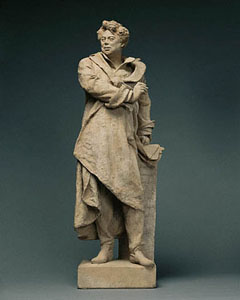• Describe the person in this portrait. Think about his clothing, posture, and facial expression.
• Just by examining this portrait, what do you think this man might do for a living? Look closely at his hands. What gesture does he make with his right hand? What is he doing with his left hand?
• Describe the moment the artist is trying to capture in this work.
• Carrier-Belleuse used the lines of Dumas's robe to lead the viewer's eyes up the sculpture to his face. The artist also wanted to capture both a restless quality and a feeling of spontaneity in this work. What evidence can you find that shows this in the sculpture?
• This work is a study for a monument to the playwright and author Alexandre Dumas père. Discuss with students monuments that they might be familiar with, such as the Lincoln Memorial. How does this work of art look like other monuments that you have seen? How does it look different?
• How would you describe the texture of this sculpture? Based on your descriptions of the texture, what can you say about the degree of finish in this work? What does the overall texture communicate about the author represented in this sculpture? |
Leaning casually on a pillar with disheveled hair signifying his creative genius, author Alexandre Dumas père turns dramatically to one side. (Père means "father," and is used after the surname to distinguish Dumas from his son, Alexandre Dumas, who was also a writer.) His robe is in disarray and his hair disheveled, while his focused expression adds dramatic intensity to the informality of his pose. In his left hand he secures sheets of his manuscript onto the pillar, which is inscribed with the titles of his most famous works. Author of The Three Musketeers and The Count of Monte Cristo, Dumas was one of the most prolific and popular French authors of the 1800s.
Sculptor Albert-Ernest Carrier-Belleuse fashioned this terracotta as a model for the large bronze monument to his close friend; the monument was erected in Dumas's hometown of Villers-Cotteret in 1884 (but was destroyed in bombings of the town during World War II and exists today only through photographs and this study). Using simple broad monumental forms for the body, he expressed Dumas's artistic power as an almost physical force. In contrast to the large, flat planes of the coat and limbs, the sculptor animated his subject's facial features and hair with a sharp tool. Since Dumas had died more than thirteen years earlier, Carrier-Belleuse derived the facial features from an earlier marble portrait bust, made by another artist and exhibited in 1876.
About the Artist
Albert-Ernest Carrier-Belleuse began his training as a goldsmith's apprentice. In 1840, another sculptor, Pierre-Jean David d'Angers, sponsored him for the École des Beaux-Arts, where he stayed only briefly, before moving to the Petite École, a school for the industrial workers of France, to study decorative arts. Between 1850 and 1855, Carrier-Belleuse worked in England, designing ceramics and metalwork models for companies like Wedgwood. In 1857 he began to exhibit large-scale sculptures at the Salon, where he garnered medals and commissions from important patrons. Emperor Napoleon III employed him in public projects during the massive rebuilding of Paris from 1851 to 1870.
Carrier-Belleuse had a sharp sense of how to combine historical elements with new technologies and the process of mass production. In his workshop, students like Auguste Rodin learned the value of series, editions, and variations made alongside unique, monumental Salon submissions. Beginning in 1876, Carrier-Belleuse revitalized the Sèvres porcelain manufactory as its artistic director.
|
